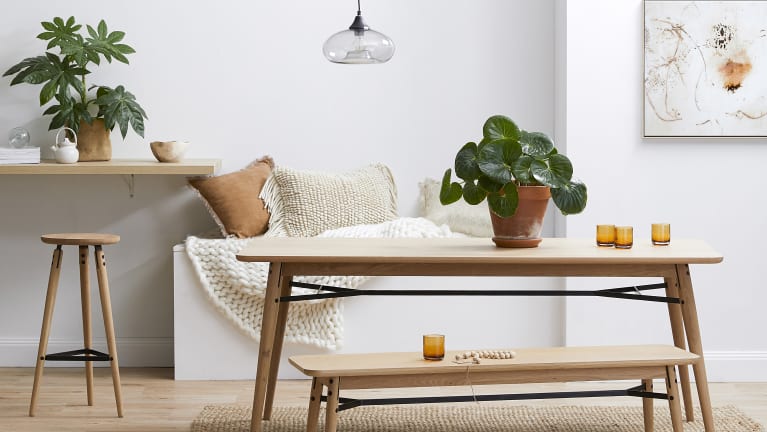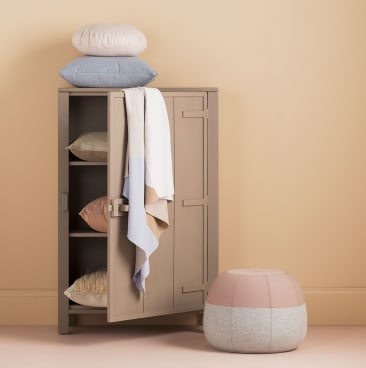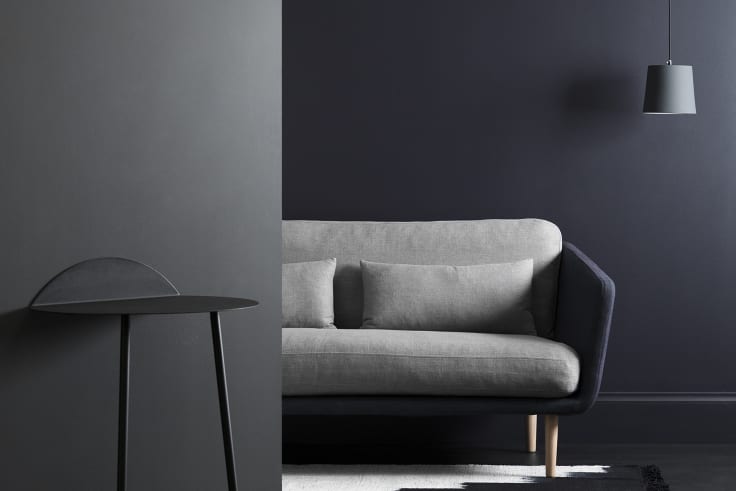
We want our homes to feel like our own, but there's no denying that when a strong decor trend comes through, we can all fall under its spell. Our homes can also be influenced by other developments, such as the wellness movement bringing an appreciation of natural materials, or emerging technology adding internet functionality. So, what's hot in the ever-evolving world of home interiors?
The clean lines of Scandinavian design make it a great choice for tight spaces.
BEYOND WHITE
White, as the perfect backdrop, won't be going far, and neither will grey. But Wendy Rennie, colour and concept manager for Haymes Paint, predicts a move to a mix of warmer-toned greys "that are easier to live with".
Colours, on the other hand, are in a state of flux. "On one side of the field we have the saturated tones of burgundy, russet, navy, mustard and deep purple," says Jessica Bellef, head of styling at Temple & Webster. "This bold colour palette hints at the '70s and echoes the decade's explosion of self-expression and celebration of individuality.
"On the other side, we have a more subtle palette. Beige and putty, nude pinks, sage, lilac and mint are seen as grounding neutrals. They work well in pared-back interiors and quiet, restorative spaces."
On the subject of neutrals, the millennial pink that has been so popular recently will start to segue into shades of berry, plum and wine, while shadowy colours, so perfect for a home retreat, will bring dark greys, deep blues and rich greens into the home-decoration spotlight.
The wellness trend is also having a big impact on palette choices. "Plants are playing an increasingly important role in interior design," says Wattyl's Sarah Stephenson. "Soft greens are mixed with warm neutrals to evoke a feeling of restfulness and a connection to nature."
Earthy colours – terracotta and clay hues – will also hold sway, while tropical prints and jungle patterns make their way into wallpapers, cushion fabrics and artwork, says Amber Cooke, general manager for furniture at Domayne. "The tropical trend is still going strong," she says.
"Think large-scale leaf prints, oversized insects, safari wildlife and exotic birds."
ROCK SOLID
Marble continues to enjoy its moment in the sun, but colour is moving beyond predominantly white Carrara, with dark tones such as ocean green coming to the fore. Though recyclable, marble is a finite resource, so eco-conscious consumers are increasingly looking to marble-look composites or more readily available stone.
"The availability of high-quality honed blue basalt has seen it find its place in the Australian DIY scene," says Vanessa Thompson, designer at Beaumont Tiles. "It has exciting colour variations, unique markings, and an exquisite ability to bring the outdoors in."
Concrete's chameleon-like qualities – it can recede quietly into the background or shine as a feature, depending on how it's used – mean it's going to be around for some time, a situation only enhanced by the fact that it can be recycled. But it won't be the only eco-aware show in town.
Another material pressing all the right environmental buttons is the new terracotta. Created from baked clay, Thompson describes it as "modern, layful and hard-wearing". Also getting a modern makeover is terrazzo, traditionally composed of waste chips of marble in cement, which has been updated with additional aggregates such as granite, quartz and glass. Using up all those leftovers gives it strong eco credentials as well as visual interest.
Embracing the burgeoning trend towards texture, timber is becoming a hero material again, and not just for floors and furniture. Wood is popping up on ceilings and as wall cladding, and re-emerging in kitchen and bathroom cabinetry.
Wood tones are growing darker, towards a warmer palette that chimes with the fashion for all things mid- 20th-century. This works well with the new, deep wall colours to create a cosy effect. For a striking counterpoint to darker timbers, metallics will still be around but in more subtle brushed brass and matt gold.
SITTING PRETTY
Furniture is another area where more than one trend is apparent. Pieces for smaller spaces are trending towards slimmer profiles and a lighter feel overall, utilising woven materials such as cane and rattan, or clear ones like glass or acrylic.
Temple & Webster's Jessica Bellef points to the clean lines of Japanese and Scandinavian design as a fantastic solution for tight spaces. Yet furniture also needs to be comfy and attractive, and our love affair with deep, buttoned Chesterfields isn't waning.
How to reconcile these apparently contradictory urges? "People want to be comfortable in their homes, so that means lounging back, not sitting upright," says Sarah Nolen of Birdblack Design. "You can achieve a nice balance by having a deep, layered lounge which is perched on slim legs."
For colour, expect warmer greys, saturated tones and subtle grounding neutrals.
More and more, home decoration is about mixing materials – think embellished textiles, marble and metal, timber and stone – as well as texture and layering. "So much can be achieved by simply playing with textures and materials, whether it be woven wicker furniture or macramé cushions," says Domayne's Amber Cooke. "Don't underestimate the power of embracing and combining different textures."
The pull toward natural materials is strong and echoes a yearning for a better connection with nature. "It's for the same reason we have become plant-obsessed over the past few years," says Temple & Webster's Jessica Bellef. "Injecting a raw, natural element into our space grounds us."
In fabrics, sumptuous velvet continues to speak to our desire for comfort; it also takes deep colour very well, boosting the moody magnificence permeating our rooms. But in quieter spaces, we're turning increasingly to the natural look. Linen, with its eco-friendly credentials and endearingly sloppy feel, is taking over the bedroom, with sludgy colours underpinning the relaxed-refuge trend.
Cotton remains an important textile. "It's still the top fabric choice in Australian homes," says Ikea's Christine Gough, who also points to the growing awareness of the impact of cotton on the environment, especially in drought-prone Australia. Some manufacturers are utilising only more sustainable varieties of cotton, and we can expect further eco-friendly initiatives as consumer awareness grows.
SMALL TALK
While new free-standing houses aren't getting any smaller, what has changed is the number of Australians living in apartments and townhouses. Apartments made up nearly half of all new homes built in the 2017 financial year, according to a Commonwealth Bank report that drew on data from the Australian Bureau of Statistics. This has helped to push down the average home size after decades of expansion.
“The trick is to be selective with the hero items you add to the room, limiting them to only one or two ‘wow’ pieces.”
Space is becoming a luxury for many, particularly in cities, and this is having an impact on home design. Tall ceilings, large windows, doubleheight voids and non-solid room dividers have all become part of architects' new-build armoury as they seek to make spaces appear larger than they are.
More specifically, spaces are set to become genuinely multi-use. With the flick of a switch kitchen shelving can disappear behind a sliding panel, a sink can be hidden by a moving benchtop. The long-anticipated "disappearing kitchen" looks set to become a reality.
The growing interest in tiny homes and compact living in general will also fuel demand for clever design. "Small spaces requires furniture that is modular, flexible, multi-functional and innovative," says Christine Gough. "Smaller homes are seeing an increasing need for furniture that can be moved, shifted or packed away, like a sofa that turns into a bed, or a coffee table that has built-in storage and can be easily rolled around the room when you need to make space."
you need to make space." It's not just in the areas of furniture and storage where space-friendly, practical-meets-pretty decorating solutions will become ever-more prevalent. "There's a definite focus on lighting," says Jessica Bellef. "Statement pendant lights stamp style on an area without sucking up valuable floor space, and table lamps instantly add polish to a petite area."
Another burgeoning trend is towards a quality-over-quantity approach that dovetails with the "buy once, buy well" eco mantra. "The savvy maximalists of the world know that balance is key when it comes to decorating small spaces," says Bellef. "The trick is to be selective with the hero items you add to the room, limiting them to one or two 'wow' pieces to create a focal point."
CLEVER KITCHENS
Smarter and speedier is where we're going, with kitchen appliances using high-tech advances to become more intuitive and energy efficient.
One example is Miele's "Dialog" oven, due in Australia next year, which "targets" food with electromagnetic waves of different frequencies that are continually adjusted for peak efficiency, cooking up to 70 per cent faster than a conventional oven. It can also cook different foods at different speeds at the same time. Another potential game changer is the upcoming Smeg blade-flame gas cooktop, which claims to be 20 per cent more efficient than traditional gas burners.
Space is becoming a luxury for many, particularly in cities, and this is having an impact on home design.
"Kitchen appliances will also be connected to a brand's database and be monitored," says Jimmy Kalotheos, managing director of Smeg Australia. "This means the service department will be alerted to an impending fault or problem with the appliance, and valuable floor space, and table lamps instantly add polish to a petite area." Another burgeoning trend is towards a quality-over-quantity approach that dovetails with the "buy once, buy well" eco mantra. "The savvy maximalists of the world know that balance is key when it comes to decorating small spaces," says Bellef. "The trick is to be selective with the will know about it immediately, probably before the consumer."
According to technology analysts Telsyte, the number of web-connected devices in the average home will grow from 17 to 37 by 2022, making reliable connectivity paramount.
"5G will support vastly more connected devices in and outside the home as it will deliver more capacity as well as faster mobile speeds, and ultimately be able to support the 'internet of things' on an even larger scale," says Ed Bobeff, director of product innovation at Telstra.
product innovation at Telstra. And the next big thing? Artificial intelligence and video analytics capabilities. "Smart home cameras will be able to detect anomalies and make homes safer," says Bobeff. "This will mean that not only will my Smart Home cameras tell me when there's motion at home while I'm away, maybe one day it could also mean that they'll tell me who that is – imagine a camera identifying the difference between a family member and a face that we haven't seen at home before." The new world beckons.
This article appears in Sunday Life magazine within the Sun-Herald and the Sunday Age on sale August 26.
Source: Read Full Article



